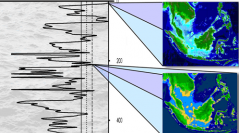

 Comptes Rendus Palevol
11 (2-3) - Pages 203-211
Comptes Rendus Palevol
11 (2-3) - Pages 203-211Multiple lines of evidence suggest that Southeast Asia was dominated by a mix of savannah, open woodlands, and evergreen forests throughout much of the Pleistocene. These conditions are ideal for early hominin subsistence; however, they would have been rare for much of the rest of Asia during glacial periods. We explore the possibility that Southeast Asia would have served as a refugium for hominins during these periods. In particular, we draw parallels with the population source and sink model proposed for northern Europe (
Savannah, Source and sink, Dispersal, Migration, Sundaland, Indochina